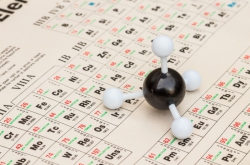Natural food lovers and those who protest against the use of chemicals in food production often demand to hear “the truth” about food - which, they believe, mostly has to do with learning about the content of chemicals in food products.
Recently, the science journal Chemistry gave an answer to their question - they’ve researched all products and made a list of those that don’t contain any chemicals. By the way, it was quite an easy task, as the list is empty - any food consists of chemicals.
DNA molecules are the basis of all life on the planet. And even its name indicates that it is a “chemical” molecule, and everything that happens in it is the result of particular chemical reactions. We all consist of different “chemicals”, and numerous chemical processes occur in our bodies every moment. Therefore, there’s no sense in believing in the numerous myths about the horrible “chemical foods”. Still, that doesn’t mean that you can eat just anything - there are lots of different chemicals, and some are definitely harmful. To get a better grasp of what you can eat and what you’d better avoid, it is better to learn why certain chemicals are added into food products. Let’s take a look at several examples.

Cucumbers
We all know that cucumbers are good for our health, as they contain lots of vitamins and water. Yet, few know that cucumber bumps also contain a strong poison that protects them from insects, as well as strong agents that attract parasitic wasps.
Chips
Chips are bad for you, that’s common knowledge. Those even barely interested in the subject know that chips are unhealthy because they contain glutamate, flavoring agents, and other chemical components. Also, every kind of chip contains toxic solanine. Yet, one should take note that it is not the presence of harmful substances that affects a product’s “harmfulness” the most, but their concentration. If we compare the harmful effect of solanine, glutamate and flavoring agents in chips with regard to their concentration, it will turn out that the most harmful ingredient are the very potatoes that chips are made of - their most “organic” and “natural” component. So, it turns out that “artificial” additives are less harmful to a human being.
Cranberries
This is a great example of how a “harmful preserving agent” is used by nature itself. Cranberries contain sodium benzoate, which prevents mold and bacteria from eating them. In the process of evolution, the plant “learned” to produce acid which is now one of its components, so people started to use this property to their own ends. And this has nothing to do with sodium benzoate being harmful or healthy.

Almond
Many believe that a handful of almonds can poison a person. Also, some say that when you smell almond you should run, as this means there’s hydrocyanic acid somewhere nearby. Truth is, almonds, as well as apples, cherries, peaches and some other plants really produce hydrocyanic acid, which they use to protect themselves. As hydrocyanic acid is quite reactive and toxic, plants don’t store it as molecules but process it into glycoside that can break down back into the acid. When you eat almonds, you eat the glycoside it contains, and only then it degrades into hydrocyanic acid and aldehyde. By the way, it is the aldehyde that smells like almonds, so artificial almond flavoring does not contain the harmful acid.
Vanilla
Many believe that vanilla fragrance is the plant’s “natural” smell, yet green vanilla pods don’t smell like that, as they don’t contain vanillin. What is more, vanillin’s true purpose is to protect the seeds from vermin, not to add flavor to pastry - so you should know that this substance is by no means a healthy one.

Coffee
Actually, there’s no such thing as the smell of coffee in wild nature, as green coffee does not smell. The smell we all know is the result of the beans’ thermal treatment in most unnatural conditions; the same unnatural process is responsible for producing most of the drink’s components, as the natural components are processed into the different substances you then enjoy. Much like cigarettes, so to say. One can say that coffee consists 100% of insecticides and artificial flavouring agents.
Another interesting fact is that when we say that all natural plants are “healthy”, we are wrong. Most tend to protect themselves with different chemical compounds. In a sense, we are eating most natural foods not because they are tasty, but because certain plants failed to develop the means of protection against us. In fact, the most tasty and healthy plants that emerged in the process of evolution are long eaten, and what we have left are their more harmful and poisonous relatives.
The assertion that all that’s natural is good for us is not exactly true. About a hundred years ago, English philosopher George Edward Moore introduced the idea of the so-called "naturalistic fallacy". Simply put, it states that there’s no reasonable basis to identify natural things something “good” and artificial things as something “bad”. “Natural and artificial” and “good and bad” are entirely different categories that we can’t compare. There are lots of natural things that we deem “bad”. There are lots of artificial things that are good for us. This is why when talking about chemistry and food, we are to concern ourselves with whether some molecule is harmful or harmless, not whether it is “natural” or not.
Let’s try to take a look at a common lemon from this point of view. We can say that it consists of ascorbic acid, starch, сіtric acid, ether oil, saccharose and water. On the other hand, we can also say that those are the antioxidant, acidity regulator, flavouring agent, sweeting agent, stabilizer and medium. In all but their name, those would be the same things, the same molecules.

E number
Everyone has heard that food additives with the E number are harmful. Yet, by every means the E number has to be the last thing to scare a consumer. The logic here is that if a component is included in the list of approved components only if it was thoroughly researched, and there is nothing to worry about.
Glutamate
Glutamate is yet another thing they scare you with. Still, if we were to remove everything containing glutamate from the shelves of supermarkets, there would be only water, salt, sugar and starch left. There are no other products that don’t contain glutamate. How so? Everyone knows what hemoglobin is; it is a protein that’s present in all of us. Proteins are made of amino acids, and glutamic acid is the one that is present in almost every protein there is. Milk protein contains up to 20% of glutamic acid, wheat protein - up to 40%. Glutamic acid is amongst the most widespread in nature, also, it is responsible for one of the five basic tastes - umami. Tasting glutamic acid means that the product contains protein. So, when we’re eating quark that is rich in milk protein, we get a lot more glutamic acid than when we’re eating chips that are said to contain too much glutamate.
Sweetening agents
Aspartame is yet another undeservedly vilified substance. When its molecule comes in contact with water, it degrades into asparagic acid, phenylalanine, and methanol. The latter is indeed a poison. Still, to start talking about the possible hazards, one should first know of its concentration, and understand its effects. Methanol itself is quite harmless, it is the products of methanol degradation (like formaldehyde and such) that are harmful. Therefore, the presence of a substance in some product doesn’t always mean that its concentration is enough to harm you.




